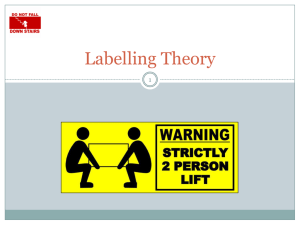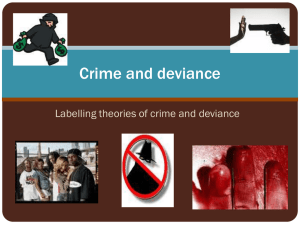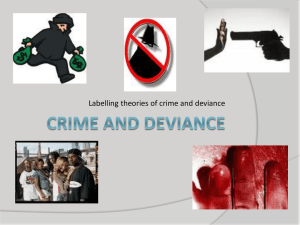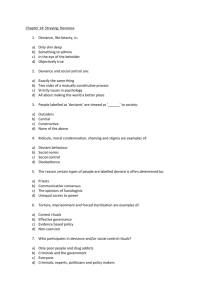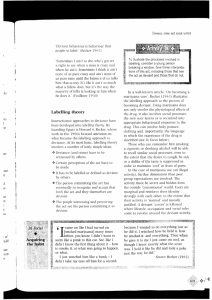Interactionism
advertisement
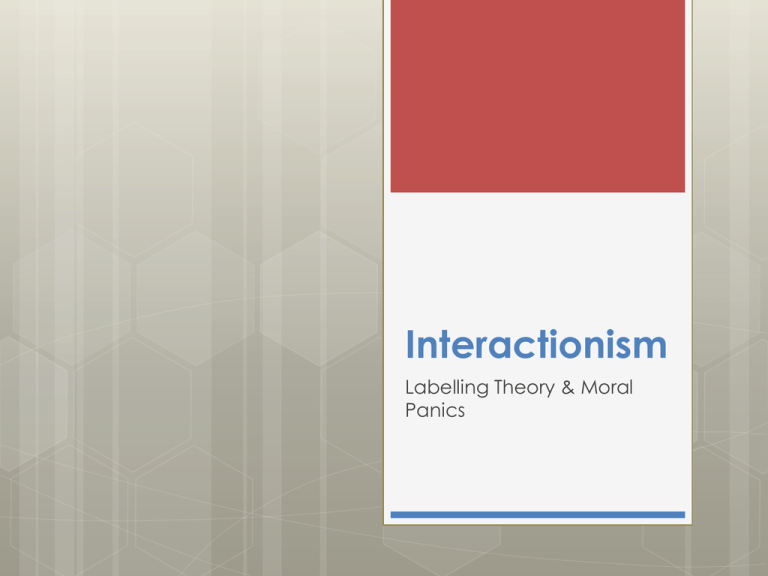
Interactionism Labelling Theory & Moral Panics Learning Objectives Key Point The interactionist view both supports and promotes the argument that crime is socially constructed. Interactionists argue that criminals are created by labels: The only difference between a criminal and a non-criminal is the label. Labelling A label is a social judgement. It is based on social reaction. The labels we give people can define their future actions and behaviour; a selffulfilling prophecy. People who are labelled can become outsiders. Labelling is one way in which crime can be considered socially constructed... Howard Becker (1973) “Social groups create deviance by making the rules whose infraction constitutes deviance, and by applying those rules to particular people and labelling them as outsiders...the deviant is one to whom that label has successfully been applied.” Read through the above paragraph and interpret it in your own words (pairs; 5mins – inc. feedback) Ext:- Include at least one contemporary example. Edwin Lemert (1951) Big influence on Becker. PRIMARY and SECONDARY deviance. Primary Deviance – the initial act Secondary Deviance – all deviance occurring after a deviant label applied Secondary deviance is usually on a much larger scale than primary! Case Studies Individually: Read through the three case studies Pairs: Discuss the questions provided. (5 mins) Becker 1. 2. 3. 4. Just because someone breaks a rule does not mean that others will define it as deviant. Someone has to enforce the rules or, at least, draw attention to them - these people usually have a vested interest in the issue... Only when the person is successfully labelled do consequences follow... The label can become a master status. Social Response Take the social response quiz. Social Response In each example, ‘rules’ are broken – but did we define them as such? Score yourself: a) = 2 point, b) = 4 points, c) = 6 points and d) = 8 points. This quiz is not about your own responses. It is about differences in social responses. If everyone in the class has an almost identical score, it suggests we share the same interpretations of acts. If everyone’s score is very different, it suggests we do not – which demonstrates the social construction of crime and deviance. How different would results be if taken by people living within different societies? https://www.youtube.com/watch?v=YDanZpek5iM Social Response/Reaction Interactionists do not assume there is one single response to a particular ‘trouble’. They argue that there are numerous possible responses – and the response is as important as the initial act. How we respond can change everything: Traditionally, people turned a blind eye to domestic violence and hardly anyone was arrested for it. Today, the police make many arrests for domestic violence. The acts have not changed – but the response to the acts have. Crime is a social construct! Responses & Identity Our identities are constructed by the way people act and respond towards us. If people treat us negatively, we may act negatively towards them. If society treats us as deviant, we may become deviant. Individual labelled as ‘deviant’ Individual is rejected/treated differently by family, friends, employers etc. Possible Stages of the Labelling Process Being rejected leads to the individual questioning their own identity: Does being rejected prove the label is correct? Note: It’s the response that causes the problems! The individual can alter their behaviour to conform and therefore lose the label…. But if they cannot change their behaviour, or the label is too strong, the individual is stuck in a deviant career. Discuss: Why might it be easier for some people to ‘escape’ or ‘lose’ labels than others? Jock Young (1971) Studied marijuana users in Notting Hill. Most marijuana users considered it a ‘peripheral activity’ Once labelled – and stigmatised - the deviance became worse: As users lost their jobs and social networks etc. they became more reliant on the drug, as a pastime and source of income. Labelling led to an amplification of deviance. Returning to Becker’s quote, he argues that ‘laws’ and ‘norms’ do not reflect the will of people. They are constructed by particular groups to serve their own interests, or because they think it might be good for society… …So what we define as crime/deviance is entirely dependent on the society, and on who is powerful within that society… …Labelling theorists are then particularly interested in what happens to the individuals who break these made-up rules. The argument is that labelling people can change their identities and change their entire behaviour patterns – usually for the worse, leading to them becoming more deviant than they were in the first place. Problems with Labelling Theory? Problems with Labelling Theory? Assumes deviants are normal people until someone slaps a label on them (Akers; 1967) Labelling theory is the study of nuts, sluts and perverts (Liazos; 1972) Criticises groups in society for coming up with the labels, but fails to look at how powerful groups benefit from people being labelled (Gouldner; 1968) Doesn’t explain the origins of primary deviance. Check your understanding! Pairs: Discuss Write a short account of what a labelling theorist like Becker might have to say about the image (5 mins) Recap In the Sociology of Health unit, we studied the work of Goffman and Rosenhan. What can you remember about their studies? Erving Goffman (1961) Labelling theorists may believe that when a label becomes a master status, it changes – and replaces – their identity. Goffman showed how this happens literally in total institutions through the process of mortification. Goffman Labelling within total institutions results in institutionalisation. Patients/inmates fear being released and losing their new identity, so often go to great lengths to remain inside. If they get out, they struggle to adapt to yet another new identity and so often end up going back in... Such institutions therefore reinforce rather than reduce deviance. Possibly another example of a label as a selffulfilling prophecy. PHENOMENOLOGY Cicourel (1976) The police (and other areas of criminal justice) build up pictures of ‘typical delinquents’ and are more likely to pursue and arrest this type of person. This means that some types of people are much more likely to have criminal records than others. Homework Criminals are not born, they are made. You wrote an essay on this as homework a couple of weeks ago; You will now add a second part to this, re-evaluating the statement using labelling theory. Deviancy Amplification & Moral Panics Deviancy Amplification Concept developed by Wilkins (1965) In some conditions, society will define a group who depart from valued norms as deviant. Negative social reaction can lead to exclusion, which can mean the group behaves more deviantly. If it does, social reaction increases with it; the two continue to rise… Moral Panic In the 1960s Stan Cohen used labelling theory and the concept of deviancy amplification to analyse the creation and consequences of moral panic. Who? Moral Panic Stan Cohen Studied societal reaction – especially in the mass media – to the 1964 clashes between the mods and rockers subcultures. He was there at the time and saw little evidence of the sort of serious violence the media was reporting... In short, the mass media had painted a distorted picture of events. https://www.youtube.com/watch?v=r61ks18Bd 7I Stan Cohen: The Consequences of the Moral Panic 1. 2. 3. Increased and heavy-handed police presence. Differences between groups exaggerated; young people made to feel they had to identify with one or the other. Image of conflict led to further violence at other resorts. Continuing disturbance led to more arrests, more media coverage, more public concern etc. The whole justice system was impacted, as judges were publicly applauded for handing out tougher sentences for minor offences. Stan Cohen: Moral Panic Mods and rockers were singled out as ‘folk devils’. Their behaviour was defined as being a threat to the social order. The 1960s was a decade of social upheaval, with many long-held norms and values being challenged. For the older generation, the mods and rockers symbolised the wrongs of society. In subsequent decades, young people have continued to be the focus of moral panics. Activity: Small Groups - 10 mins What recent moral panics have there been in UK society? Research one deviant group and identify how their behaviour – and societal reaction to it – fits with the deviancy amplification model. Nameless Folk Devils…? Trade unionists Football hooligans Punks Skinheads Black muggers Ravers Goths Young Muslims Chavs/Neds ??? McRobbie & Thornton (1995): “Moral Panic is an outdated concept...” Frequency The frequency of moral panics has increased: they are no longer noteworthy. Context In the past moral panics would scapegoat a group and create ‘folk devils’. Today there are many viewpoints and values in society. Reflexivity Because the concept of moral panic is well-known, some groups actually try to create one for their own benefit. Difficulty Because there is less certainty about what is unambiguously ‘bad’ today, moral panics are harder to start. Rebound People are wary about starting moral panics as there is the possibility of it rebounding on them, e.g. John Major’s ‘family values’ campaign. Homework Find a contemporary example of a moral panic (look for recent newspaper articles online, for example). It doesn’t necessarily have to be about crime… …Write a brief blog/summary of the article, using the concepts and studies covered in this unit so far.
